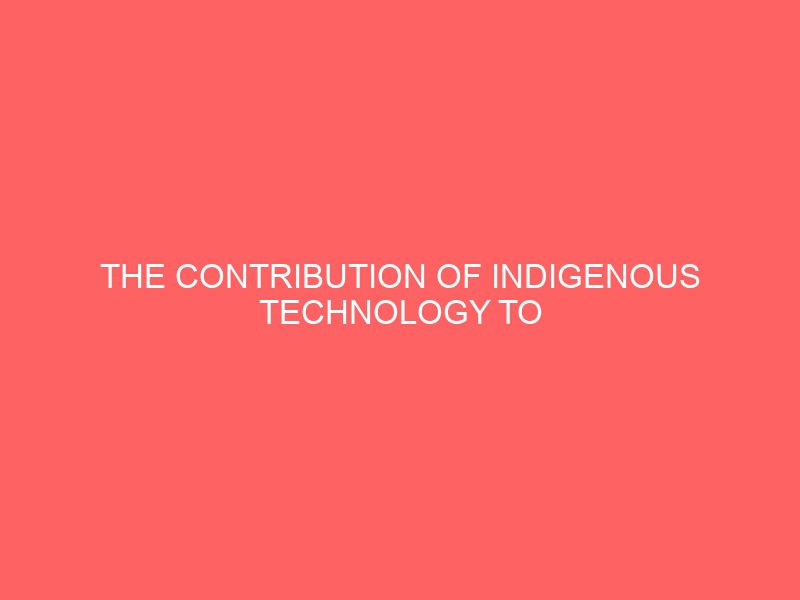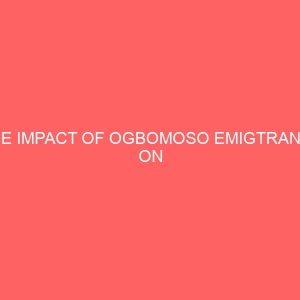Description
ABSTRACT
Bronze casting is an aspect of visual arts which has played a significance role in Benin culture. The trade between Benin and European enhanced the production of bronze casting in Benin. Today Benin bronze casting has attained a high level of artistic importance in Nigeria.
TABLE OF CONTENTS
ABSTRACT
CHAPTER ONE
1.1 INTRODUCTION
1.2 AIMS AND OBJECTIVE OF THE STUDY
1.3 SCOPE OF THE STUDY
1.4 SIGNIFICANCE OF THE STUDY
1.5 METHODOLOGY AND PROBLEMS
1.6 LITERATURE REVIEW
NOTES AND REFERENCES
CHAPTER TWO – ORIGIN OF THE BENIN PEOPLE
2.1 HISTORICAL BACKGROUND OF THE BENIN PEOPLE
2.2 GEOGRAPHICAL LOCATION
2.3 BENIN AND THE EUROPEANS
CHAPTER THREE – BRONZE CASTING
3.1 ORIGIN OF BRONZE CASTING
3.2 THE TECHNIQUE OF BRONZE CASTING
3.3 THE GUILD SYSTEM
CHAPTER FOUR
4.0 THE CONTRIBUTION OF BRONZE CASTING TO BENIN
CONCLUSIONS
NOTES AND REFERENCES
BIBLIOGRAPHY
CHAPTER ONE
1.1 INTRODUCTION
This essay examines the contribution of indigenous technology to Benin economy. Essentially, this study will be based on the origin of bronze casting in Benin and its contribution to the economy. Benin, which was one of the most powerful Kingdom in West Africa before the coming of the European is gifted with rich cultural and traditional art works. It flourished as a city state from the 13th century until the British punitive expenditure of 1897 which saw the looting of Benin art works in it’s multitude to Europe and other parts of the world. Bronze casting in Benin staffed to take its full shape in 1280 A.D during the reign of Oba Oguola. Benin is said to have derived it’s arts of bronze casting from Ife in the 14th Century. This statement leads us to Igueghae story; as the bronze caster who went to learn this art of casting in Ife. However, the lost wax (cire perdue) method of bronze casting had been known earlier in Benin and the works from Benin were more stylized than that of Ife.
Bronze was already a universal value and enjoyed great respectability among all groups, all people, in all cultures in Benin kingdom before bronze casting actually became one of the professionalized royal crafts in Benin Kingdom. Bronze was always a royal ornament for power, splendour, for adornment and was so valued that even the image of the Oba, both past and present could proudly be represented in it. In Benin nation, Bronze was generally regarded as precious and because it was precious, it was considered incorruptible. It could neither rust nor rot.
In Benin-city, the bronze sculptors were mainly for the sovereign (the palace). The palace was the Chief patron of the group, reciprocally, the palace paid in kind to the group members that were involved in bronze casting and paid also for services including technical expertise. The craftsmen also received protection as a monopoly of the craft. The plague represented scenes from the life of the Benin Peasant, warriors, musicians and also important events that took place in the palace. In pre-colonial time, was implements, household utensils were made of brass. Those bronze casters just like other guild system in Benin had a specific area where they are settled and they had their own guild name in which they are known. They are organized on a family basis and a non-family member cannot be a member of the guild. This guild quarter of bronze casters is still in existence in Igun Street present day in Benin. It is referred to as the “Home of Bronze”.
1.2 AIMS AND OBJECTIVES OF THE STUDY
This study on “the contribution of Indigenous techno1og to Benin economy, a case study of Bronze Casting will focus on the Benin Bronze Casting. In other words, this study is an attempt to give a comprehensive understanding of the artistic excellence of the Benin bronze casting and its stylistic differences from other craft-tradition of Africa.
The researcher’s purpose is to show ho much we really know about ancient Benin and thereby take stock of our present knowledge providing a firmer basis for future research on bronze casting to Nigeria and even the world culture development.
Bearing in mind that the art of bronze casting was and is still a family affair, it is of advantage to study the traditional local technique and find the possible ways of improving this craft. It is through a research of this nature that this objective can be achieved.
This project is also aimed at how the craft of bronze casting in the olden- days have been utilized on various aspect of craft production by the people of Benin and their own unique style and how bronze was used to document events in the preliterate Benin economy.
1.3 SCOPE OF THE STUDY
The scope of this study will cover the origin of Bronze casting in Benin, so also this study will be based on the influence of bronze casting on the society, the traditional arts and culture, the economy and its relation with other communities.
This research work is divided into four chapters, the introductory part of the essay under which we have purpose, scope, and significance of the study, methodology, limitation and literature review. Also, we have in chapter two, the geographical and historical background of Benin. The third chapter explains the origin of bronze casting in Benin, the guild system and essentially the technique of bronze casting (how bronze is being cast). The fourth analyses the contribution of bronze casting on the society in the area of social, economic and political impact, while the last chapter is the conclusion and recommendation of the work.
1.4 SIGNIFICANCE OF THE STUDY
This research work will create the opportunity of understanding the origin of bronze casting in Benin, how the bronze in Benin is being cast, how the different guilds in Benin were organized and essentially gives us insight as to how bronze casting has contributed to the economy of Benin and to the society at large both in the pre-historic times and in our contemporary time.
1.5 METHODOLOGY AND PROBLEMS
Different research methods will he adopted in collecting the data for the work, but a great deal of this work will rely on oral information which will be conducted in Igun Street (Benin City).
Written sources were also consulted both the primary and secondary sources used included published books, published articles which are related to this topic or discussion.
The library and archival also served as an effective indicator of other sources and that is complied with photographic analysis which made the work more relevant.
The process of data collection began Edo State archival, where few related materials on the subject matter was found. This necessitated the researcher to go to other libraries for more materials. As a result of this, the researcher visited Edo State library for more materials.
Also, Oral Interviews with prominent casters and the people of Edo
State was conducted. They include Mr. Ehimona, Senior lecturer and deputy dean in the department of Fine Arts in the University of Benin. Mr. Sunday Ihama a bronze caster who had worked for over 10 years as a caster in Igun Street, Mr. Moses lgbmosun was also interviewed. All of these people supplied the researcher with facts and clues on the subject matter of this research work.
The researcher equally explored the Edo State national museum for some data collection.
1.6 LITERATURE REVIEW
Many research works were consulted. This included articles, journals and magazines. For most among the works used for this dissertation was Aghama Omoruyi (1986) “Benin Series, a new dimension in Benin Studies” gave a brief history on Benin and their arts .and crafts. He emphasized the importance of Bronze casting in Benin, its origin and influences.
Another important text is the work of John O. Igbinokpogie “The Benin Kingdom historical and environmental perspectives which he reveals the Benin people and their environment. Through this work, one is able to view the Benin people, their environment and culture.
In his contribution, Philip Aigbana Igbafe “Benin under Administration”, he explained vividly the indigenous background of Benin, he also shed light on how the guild system is organized and the origin of Bronze casting in Benin. According to him, members of guild are divided into three age grade for effective administration.
Also, R. E. Bradbury also (1973) “Benin Studies” deals extensively with the Benin Bronze casting, the Ikegbo and the Benin Cult of the hand, he wrote that the Benin plagues and other bronzes were intended to convey some information about specific events or particular persons. He also stated that bronzes contain much potentially valuable information about Benin Society, culture and history.
According to Jacob Eghareveba (1968) in his book, “A. short history of Benin”. He helps to shed light on the foundation of Benin Empire, the reign of various kings in Benin. This helped in the historical background of Benin as a reference to this work.
In his work, Prince Eva Basirai Eweka “The Benin Monarchy, Origin and Development”, he gave a vivid account on the Benin People and their culture. This helped to know the role of the Oba in the Benin Political system.
Also Nkata and E. N. Arinze, (1989) “The lost treasures of Ancient Benin”. Also he gave an account on the punitive expenditure f 1897 which saw the looting of Benin Arts in its multitude to Europe and other parts of the world. This helped in the introductory part of this work.
Aghama Omoruyi “Benin Anthropology” also gave a comprehensive analysis more on the historical background of Bronze casting. The book helped in understanding the origin of Bronze casting in Benin and how the guild system was organized.
Furthermore, A.F.C Ryder (1969) “Benin and the Europeans” stated how the Portuguese traded with the Binis and imported Brass as an object of exchange, according to him, the increase use of Brass may have influenced the production of Bronze casting in Benin at a time when the mental would have become available in quantity sufficient to permit experimentation and continuous production.







